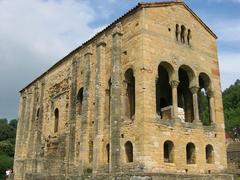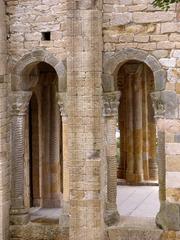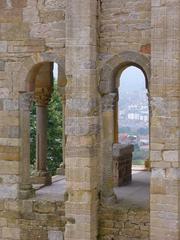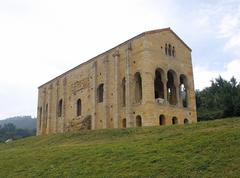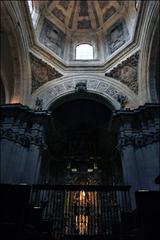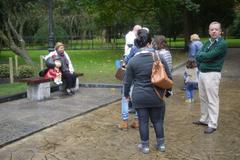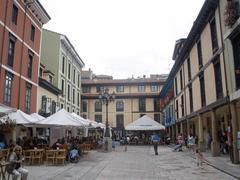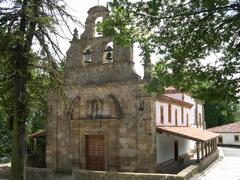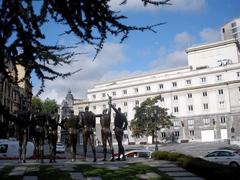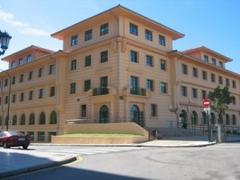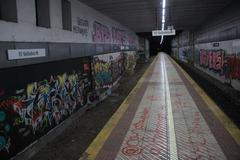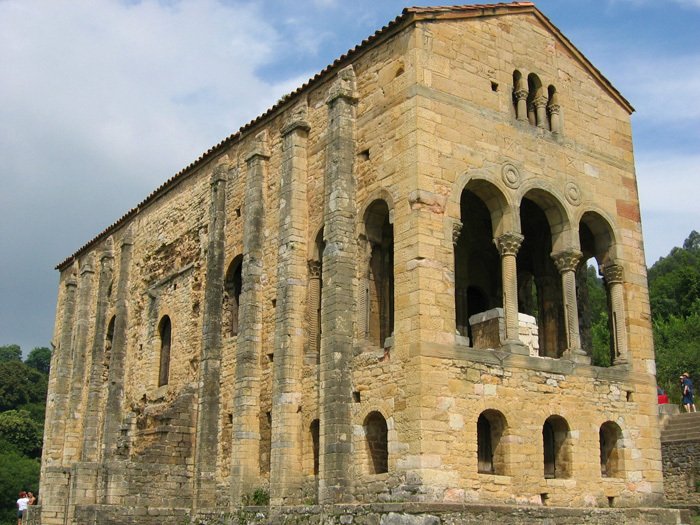
Santa María del Naranco: Visiting Hours, Tickets, and Oviedo Historical Sites Guide
Date: 14/06/2025
Introduction
Santa María del Naranco, perched on the slopes of Monte Naranco near Oviedo, Spain, is a masterpiece of Asturian pre-Romanesque architecture and one of the most significant monuments of early medieval Europe. Built in the mid-9th century as a royal palace for King Ramiro I and later transformed into a church, it exemplifies the artistry and engineering of the Kingdom of Asturias—a Christian stronghold during the Reconquista. Its architectural innovations, sculptural details, and scenic position make it a highlight of Spain’s UNESCO-listed heritage (Academia.edu, Spotting History, UNESCO). This guide details its history, cultural significance, visitor information, travel tips, and nearby attractions to help you plan an enriching visit.
Table of Contents
- Historical Context and Evolution
- Architectural Features and Innovations
- Cultural Importance
- Visitor Information
- Accessibility and Travel Tips
- Nearby Attractions
- Frequently Asked Questions (FAQ)
- Preservation and Responsible Visitation
- Key Dates and Milestones
- Plan Your Visit
- Sources and Further Reading
Historical Context and Evolution
Santa María del Naranco was constructed in 848 CE, originally as a royal aula regia (ceremonial palace hall) for King Ramiro I of Asturias. This period marked the consolidation of Christian power in northern Spain, as the Kingdom of Asturias resisted the southward expansion of Islamic rule (Academia.edu). The building’s transformation into a church occurred in the 12th century, when it was consecrated as Santa María del Naranco, with minimal structural changes due to its already solemn and monumental design.
Its strategic position overlooking Oviedo symbolized royal authority, Christian resilience, and the city’s importance along the Camino Primitivo, the oldest pilgrimage route to Santiago de Compostela (UNESCO, Pilgrimage Traveler).
Architectural Features and Innovations
Layout and Structure
Santa María del Naranco is a rectangular, two-story building—approximately 20 meters long and 6 meters wide. The lower floor, likely used for storage or as a crypt, is barrel-vaulted and sparsely decorated. The upper hall, accessed via an external staircase, was the main ceremonial space and later the nave of the church. It features a soaring barrel vault supported by six transverse arches, a technical achievement for its time (Spotting History).
Miradors and Light
Both eastern and western ends of the upper floor are flanked by miradors (viewing galleries) with triple-arched windows, flooding the hall with natural light and providing panoramic vistas over Oviedo and the Asturian landscape.
Decorative Elements
The monument is adorned with Corinthian-inspired capitals, geometric and vegetal motifs, and cord-like patterns that blend Visigothic, Carolingian, and Byzantine influences (Fascinating Spain). The Greek cross—a symbol of the Asturian monarchy—and 32 sculpted medallions featuring animals, birds, and fantastic creatures emphasize its artistic sophistication and symbolic richness.
Engineering Techniques
The advanced use of barrel vaulting reinforced by transverse arches allowed for a spacious, column-free hall. The building’s precise ashlar masonry, using local limestone and sandstone, underscores its durability and the technical skill of its builders (Hidden Architecture).
Cultural Importance
Santa María del Naranco is the most celebrated example of Asturian pre-Romanesque art, a regional style that emerged under the political and cultural pressures of the 9th century (Teacher Curator). Its monumental scale, innovative architecture, and decorative program reflect the ambitions of the Asturian monarchy and the region’s role as a bastion of Christian identity.
The site’s conversion into a church and its association with the Camino de Santiago underscore its enduring spiritual resonance. Today, it serves as a living symbol of Asturian heritage, inspiring scholars, artists, and visitors from around the world (UNESCO, Culture Lovers).
Visitor Information
Location and Access
Santa María del Naranco is about 4 km from Oviedo’s city center, accessible by bus (A1 line to “Prerrománico” stop), private car (ample parking available), or a scenic uphill walk (about 1 hour) (La Guía Viajera). The monument is not located within the old town, so plan your transport accordingly.
Visiting Hours
- April to September: Open daily, generally 10:00 AM – 6:30 PM, with guided tours throughout the day.
- October to March: Reduced hours, typically until 5:00 PM.
- Closed on Mondays and some public holidays.
- Free entry on Mondays (guided tours not available these days).
- Always check the official Turismo Asturias website for current schedules.
Tickets and Guided Tours
- Admission: €4 per person (includes guided tour, usually in Spanish). Cash or card accepted.
- Discounts: Free for children under 12, residents of Asturias, and on Mondays (self-guided only).
- Capacity: Group sizes are limited, especially during peak seasons. Early arrival is advised.
- Guided tours: Approx. 30 minutes, providing rich historical and architectural context.
- Languages: Tours primarily in Spanish; non-Spanish speakers should prepare alternative materials.
Accessibility and Travel Tips
- Mobility: The upper hall is accessible only by stairs; there are no elevators or ramps due to the historic fabric. The site is not fully accessible for visitors with reduced mobility.
- Facilities: Basic restrooms available. No cafés or shops on site; bring water, especially in summer.
- Dress: Wear comfortable shoes for uneven terrain and stairways. Prepare for variable weather, as the site is exposed.
- Photography: Allowed without flash or tripods, to preserve interiors.
Nearby Attractions
- San Miguel de Lillo: Another UNESCO-listed pre-Romanesque church, just a short walk away.
- Monte Naranco: Offers hiking trails and panoramic views of Oviedo.
- Oviedo Cathedral: A key pilgrimage destination in the city center.
- Interpretation Centre of Asturian Pre-Romanesque Art: Nearby, with educational resources and exhibitions (Packing Up the Pieces).
Frequently Asked Questions (FAQ)
Q: What are the Santa María del Naranco visiting hours?
A: Typically open daily from April to September, with reduced hours October to March. Closed on Mondays and public holidays. Always verify on the official website for updates.
Q: How much do tickets cost?
A: €4 per person, including a guided tour. Free entry on Mondays, but tours are not offered.
Q: Are guided tours available in English?
A: Standard tours are in Spanish; check with staff for materials or consider advance preparation.
Q: Is the site accessible for those with mobility issues?
A: Accessibility is limited due to stairs; the upper floor is not wheelchair accessible.
Q: Can I take photographs?
A: Photography is allowed without flash or tripods.
Q: How do I get there from Oviedo?
A: By bus (A1 to “Prerrománico”), car, or a 1-hour walk from the city center.
Preservation and Responsible Visitation
Santa María del Naranco is a UNESCO World Heritage Site, protected by strict preservation measures. Visitors must respect all barriers, avoid touching stone surfaces, and follow staff instructions. Eating, drinking, and smoking are prohibited inside the monument. Group sizes are controlled and some areas may close temporarily for conservation (UNESCO).
Key Dates and Milestones
- 848 CE: Construction completed as royal palace for King Ramiro I.
- 12th century: Converted into a church.
- 1885: Declared a National Monument.
- 1985: Designated as a UNESCO World Heritage Site.
Plan Your Visit
- Check official schedules: Turismo Asturias
- Combine with nearby attractions: Include San Miguel de Lillo and Oviedo Cathedral in your itinerary.
- Download the Audiala app: For guided tours, interactive maps, and real-time updates.
- Support local businesses: Explore Oviedo’s center for dining and shopping.
Sources and Further Reading
- La construcción de Santa María del Naranco Oviedo: Su función y significación a través del análisis arquitectónico, Academia.edu
- Santa María del Naranco Church, Spotting History
- Monuments of Oviedo and the Kingdom of the Asturias, UNESCO World Heritage Centre
- Santa María del Naranco Pre-Romanesque Art, Fascinating Spain
- Palacio de Santa María del Naranco and San Miguel de Lillo, Teacher Curator
- Church of Santa María del Naranco, Hidden Architecture
- Iglesia de Santa María del Naranco and Church of San Miguel de Lillo: Architectural Marvels of the Asturian Kingdom, Culture Lovers
- Santa María del Naranco, Turismo Asturias
- Churches of Monte Naranco Oviedo, Packing Up the Pieces
- Church of Santa María del Naranco, Senditur
